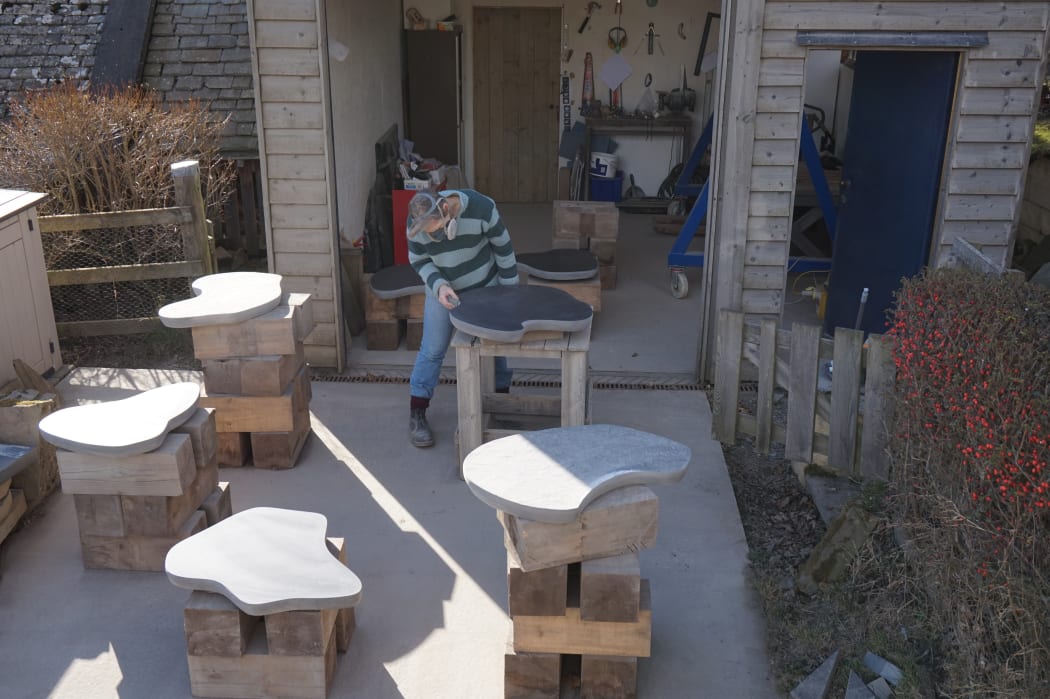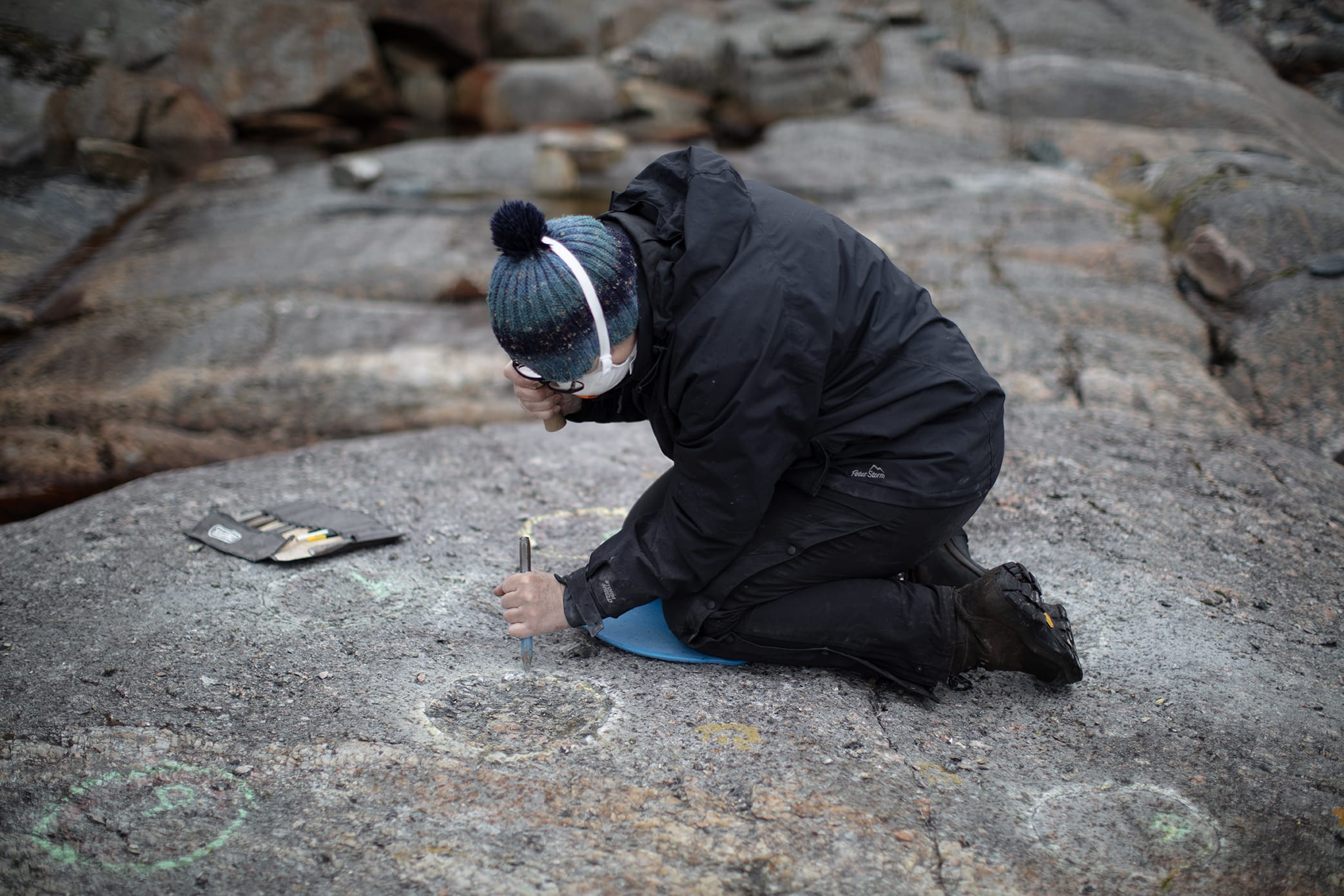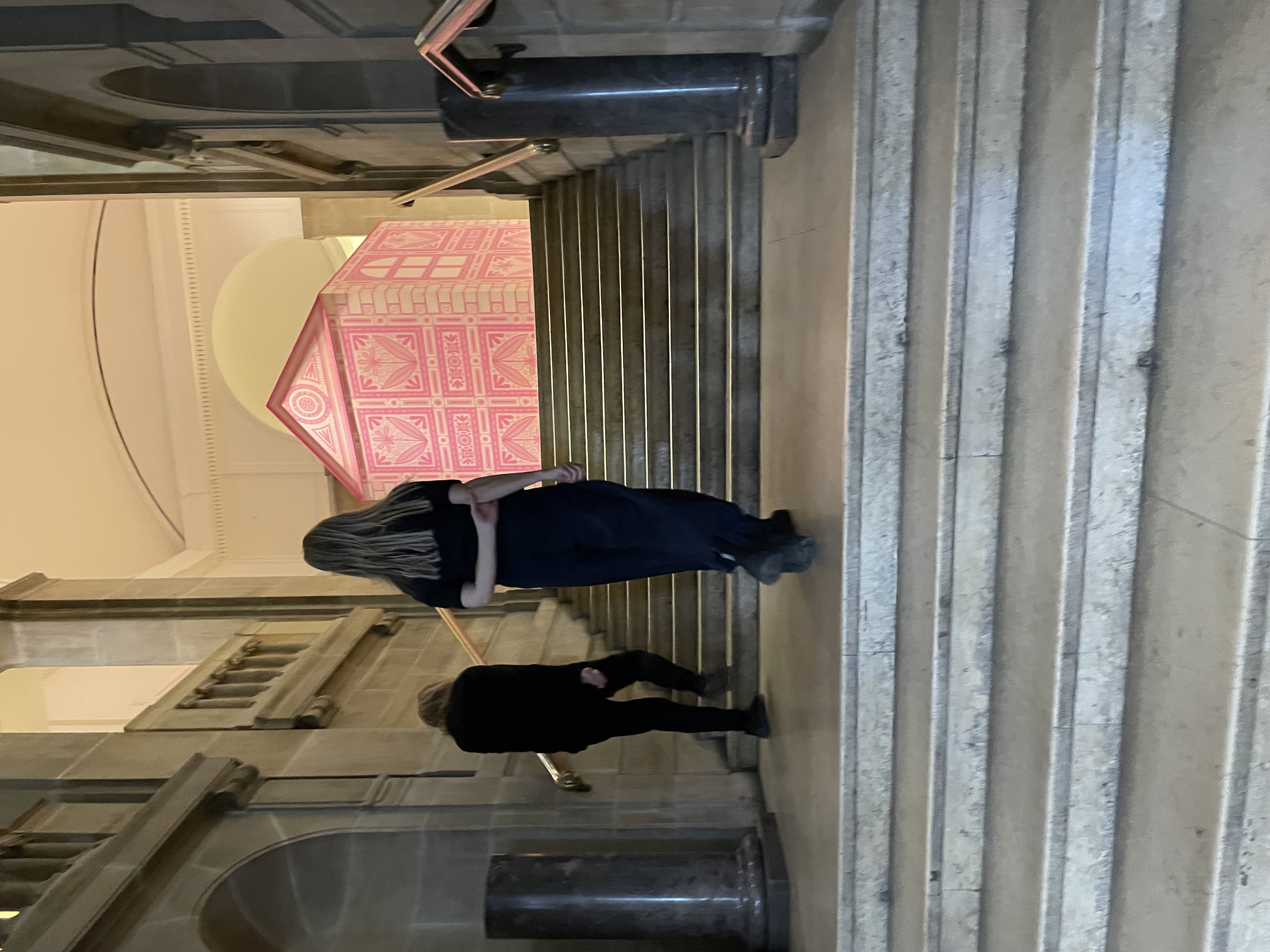
Each month, we’re sitting down with one of our Academicians to discuss their practice, influences and upcoming projects. This month, we're talking to Mary Bourne RSA about collaboration, commission, and the powerful importance of supporting emerging artists.
Natural stone is your principal medium. Could you tell us about your first experiences sculpting with stone?
I first carved stone as part of my course work at Edinburgh College of Art, where Jake Harvey RSA worked as an experienced and inspiring teacher of the technique. I found it incredibly demanding physically, and my hands were a swollen mass of grazes and bruises, but I immediately took to its language of form and texture. I seemed to have no trouble seeing the sculpture inside the block of stone, which is something people often find quite challenging, being distracted by the block’s flat surfaces. I have always loved the stone itself – my pockets are all stretched out of shape from bringing back pebbles (sometimes boulders) from walks. The character of the rock, what it brings to the piece through its age and geology, is an important aspect of my work.

Mary Bourne RSA, Carving bedrock, photo Maria Konstanse Bruun.
You're based in the rural northeast of Scotland. How does living in a rural landscape influence your practice?
Living in the Rural North East influences my practice in all sorts of ways. For a start, I have always needed time and space to hear my own thoughts – there is so much going on in cities I find it difficult to hear myself think there.
Then there is the direct influence on my work. I am interested in how we interact with the world we live in and, in a farming area, this is clearly visible through the seasonal changes in agriculture. In addition to this, I hear and see daily how economic, political and environmental conditions locally and globally are influencing food production and land management, something essential to all our lives.
The passage of time has always been of fundamental interest to me, as well as how things change over time. In the rural landscape I can look out of my window and see the marks of centuries of human activity in the landscape – a gean tree blooming in the garden of a long fallen down house, a hillside crisscrossed with old roads, marking the way to places that used to be of significance. I love the un-tidied-up character of this area – old farm implements, standing stones, discarded domestic detritus are all here, just lying around. And this is overlain by more recent developments – forestry plantations, and now the ever-proliferating windfarms with the guddle of infrastructure that goes with them. Since 2021, I have been collaborating with artist Lynne Strachan on a project called Cabrach Reconnections, which has investigated many such aspects of the remote rural area near my home – you can learn more about this here.
Over the years, I have developed a number of projects locally in my area where there has been almost no arts provision, and this has been one of the most satisfying strands of my practice. I love to work alongside all sorts of different people – teachers, countryside rangers, river wardens, Highland estates, farmers – as well as all age groups, and to feel my work has a social purpose. My ambition is for my work as an artist to be seen as of equal relevance here as that of my neighbours: farmers, blacksmith, carpenter, shopkeeper.

Mary Bourne RSA, studio.
You have completed more than thirty commissions for public places. Do you have a favourite commission you've worked on so far?
My favourite commissions have been in rural places where I feel most at home, where I have had time built into the process to allow for getting to know the place, and support to get to know local people.
A piece called Water Cut, which I made for the remote Mallerstang Valley in East Cumbria in 1996, is one of my favourites. This piece was commissioned to mark the source of the River Eden high up the valley side, and it was the first of a series of sculptures commissioned along the long-distance footpath that follows the river to the sea. The original site was changed - thanks to local knowledge - from a rather messy spot where the foot path crossed the embryonic river, to a point where the land falls away and a vista of the Eden River valley opens up. I feel here the idea, the sculpture and the location add up to more than the sum of their parts, which is what you always hope for in a place-specific piece. One of my proudest achievements is that Water Cut has its own Tripadvisor page, having become a local landmark and a destination in itself.

Mary Bourne RSA, Water Cut, Cumbrian limestone, photo Val Corbett.
Your commissioned work involves collaborating with a range of people, planners, local communities, architects, to name a few. Could you tell us how you approach collaboration
There are lots of different ways of approaching this process – this is how I do it.
First off, I make a rule of not submitting design work unless it is paid for. The design is the artwork, and if a client doesn’t understand and value this, it doesn’t bode well for the commission. Also, I can’t afford to work for nothing!
If I decide I am interested in a commission, I then have to work out if I share the values of the client and design team. A well-considered brief can speak volumes about the potential of the project, while inexperience and muddled thinking are often all too apparent – and a big red light! Not everyone can collaborate successfully – if you are not on the same page, it’ll be like wading through treacle, and is not likely to be very successful. When it does work, though, and everyone is pulling in the same direction, sparking ideas off each other, it is stimulating and elating.
Once appointed, I wrestle down the urge to start designing too early. In the tradition of Patrick Geddes, I want first to learn about the place through spending time there and observing how it is used, as well as by talking to people who live and work there to find out what it means to them. There are all sorts of people it is good to talk to – if you are by a river, for example, fishermen are wonderful as they spend so much time there, standing still and watching quietly.
I also like to understand the plans for the area, not just from looking at them, but by hearing about them from those who have drawn them up.
Understanding the ambitions for the future is really important. Then, finally, I think about how I can add to the place in light of what I’ve learned. Like everything in life, sometimes it works better than others, but in my experience having a client with the confidence to involve you early in the project, to invest in the research period and not hurry the design too much is the best indicator for success.

Mary Bourne RSA, White Wood Stone Works, granite, commissioned by Deveron Projects for The White Wood, Huntly, photo Ross Fraser MacLean.
In 1985, you were awarded a RSA John Kinross Scholarship to Florence, and in 2015 you approached the RSA to put on Andiamo!, celebrating forty years of the Scholarship. What inspired you to celebrate the Scholarship, and do you have any words of wisdom for graduates applying in the future?
In 2015, I was in Tuscany again on another residency and took the opportunity to revisit Florence. Walking the streets familiar from my Kinross Scholarship thirty years previously brought home what a formative experience the scholarship had been, how its timing immediately after graduation made it one of those key experiences that come to define your life. It was like I was meeting my young self at every corner. Simultaneously, I felt compassion for this young self for all the stress of being inexperienced and trying to find a path, and gratitude for the store of experiences that that person had laid in to see me through life.
Going to a different place not only exposes you to that place, but to the experience of seeing yourself in a different context. It’s a test of assumptions about yourself that you hadn’t even realised you were making, and I was interested to learn from other Kinross Scholars how they felt their time in Florence had affected them. We devised the exhibition not only as a showcase for Scholars’ work, but as a collection of stories covering people’s time in Florence, what has happened since, and how the Florence experience has shaped this. By the time the exhibition was shown, the Scholarships had been running for forty years, and that meant around four hundred people had benefitted from them.
This collection of human stories was the core of the project for me – a profound, moving and inspiring endorsement for the value of travel, and what it is to be just starting out.
I guess my advice for new applicants above all would be to make sure you have really good images and/or video that show your work clearly and to their best advantage. In addition to this, text that is concise and comprehensible is very welcome – this is not an academic essay competition! The selection panel only has your application to go on – never assume we have any other knowledge of your work.

Mary Bourne RSA, John Kinross Scholarship sketchbook, photo Abby Quick.
And finally, you were on the hanging comittee for RSA New Contemporaries this year, helping select graduates from the 2024 degree shows. What was your experience of working on the exhibition, and how important is it to you to support the work of emerging artists?
Working on RSA New Contemporaries was a wholly positive experience. The ambition and originality of the work in the show was hugely impressive, as was the maturity of the exhibiting artists as they negotiated the practical problems of being part of a very big show in an old and characterful building. I am so encouraged by the experience, being with a new generation fired up by making things, expressing feelings, communicating ideas…
The week of installation was one of the most hopeful experiences I’ve had for ages, not least because of the thoughtful, collaborative approach of the RSA New Contemporaries Convenor, Robbie Bushe RSA, and of my fellow Hanging Committee members, as well as the consistently constructive attitude of the RSA team members. Supporting emerging artists is very important to me. We live all too briefly on this earth, but to know that the fundamental creative activity of making art continues from generation to generation – speaking from generation to generation – is a great affirmation of the continuing strength of our collective humanity.

Mary Bourne RSA, RSA New Contemporaries install
Explore Mary Bourne RSA's work further

